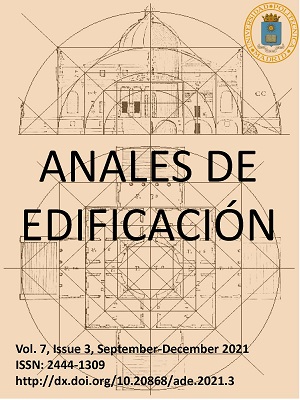Determinación de las propiedades de flexión del contrachapado de lauán mediante ensayos de flexión por compresión = Determination of bending properties of lauan plywood by compression bending tests
DOI:
https://doi.org/10.20868/ade.2021.4970Keywords:
lauán, madera contrachapada, ensayo de flexión por compresión, resistencia a la flexión, El módulo de Young, lauan, plywood, compression bending test, bending strength, Young’s modulusAbstract
Las propiedades de flexión de la madera contrachapada generalmente se obtienen a partir de pruebas estándar de flexión de 3 o 4 puntos. Estos ensayos han sido ampliamente cuestionados debido a la influencia del método de medición de la deflexión y debido a la concentración de tensiones en las proximidades del área de contacto de la muestra con el dispositivo de carga. Algunos autores han propuesto el uso de ensayos de flexión por compresión para estos fines. Pero los resultados relacionados con la resistencia son más bajos de lo esperado e incluso más bajos que los de la prueba de flexión de 3 puntos. En este artículo, describimos algunas soluciones, como aumentar la longitud de las muestras y determinar la resistencia, incluidos los efectos de la tensión a la compresión, y no solo a la flexión. En este sentido, se realizaron ensayos de flexión por compresión para medir las propiedades de flexión -resistencia y módulo de Young- de contrachapados de lauan de 9 y 12 mm. Finalmente, los resultados de las pruebas se comparan con los valores del Estándar Agrícola Japonés (JAS) para madera contrachapada para verificar la aplicabilidad.
Abstract
The bending properties of plywood are usually obtained from standard 3 or 4 points bending tests. These tests have been thoroughly questioned because of the influence of the deflection measurement method and because of the stress concentration in the vicinity of the specimen contact area with the loading fixture. Some authors have proposed the use of compression bending tests for these purposes. But the results concerning strength are lower than expected and even lower than those from 3 points bending test. In this paper we outline some solutions like to increase the length of the specimens and to determine the strength including compression, and not only bending, stress effects. In this sense, compression bending tests were conducted to measure bending properties -strength and Young's modulus- of 9 and 12mm lauan plywood. Finally, tests results are compared with values from Japanese Agricultural Standard (JAS) for plywood in order to check applicability.
Downloads
References
Ainsworth, D. M. Marketing oriented strand board in Japan. An investigation of Japanese requirements. (Doctoral thesis). University of British Columbia (1995)
ASTM D790. Standard test methods for flexural properties of unreinforced and reinforced plastics and electrical insulating materials (2017)
ASTM D3043. Standard test methods for structural panels in flexure. (2017)
Baño, V., Argüelles Bustillo, R., Regueira, R. y Guaita, M. Determinación de la curva tensión-deformación en madera de pinus sylvestris l. Para la simulación numérica de vigas de madera libre de defectos. Materiales de construcción vol. 62, 306 (2012). 269-284 (in Spanish)
Buchanan, A.H. bending strength of lumber. Journal of structural engineering. Vol. 116, no 5 (1990). 1213-1229
Forest Product Laboratory. Wood handbook – wood as an engineering material. U.S. department of agriculture, forest service, forest product laboratory. Madison, Wisconsin. (1999).
Fukuda, H. A new bending test method of advanced composites. Exp. Mech. 29 (1989) 330-335
Japanese Agricultural Standard for Plywood (2017) (in japanese)
Lienhard, J. Bending-active structures. Form-finding strategies using elastic deformation in static and kinetic systems and the structural potentials therein (doctoral thesis). University of stuttgart. Stuttgart, germany. (2014).
Uemura, M. Evaluation of mechanical testing method for unidirectional carbon-fiber reinforced plastics. Trans. Jap. Soc. Comp. Mat. 10 (1) (1984) 7-16
UNE-EN 789 Timber structures. Test methods. Determination of mechanical properties of wood-based panels. (2006) (in spanish)
Downloads
Published
Issue
Section
License
Anales de Edificación does not charge authors for processing or publishing an article and provides immediate Open Access to its content. All content is available free of charge to the user or his institution. Users are permitted to read, download, copy, distribute, print, search or link to the full text of articles, or use them for any other lawful purpose, without prior permission from the publisher or author. This is in accordance with the BOAI definition of open access.
- Authors retain the copyright and grant to the journal the right to a Creative Commons attribution / Non-Commercial / Non-Derivative 4.0 International (CC BY NC ND) License that allows others to share the work with an acknowledgement of authorship and non-commercial use.
- Authors may separately establish additional agreements for the non-exclusive distribution of the version of the work published in the journal (for example, placing it in an institutional repository or publishing it in a book).
Unless otherwise indicated, all contents of the electronic edition are distributed under a Creative Commons license.












